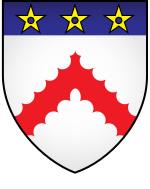Keble College
| Keble College | |
|---|---|
 |
|

Blazon: Argent, a chevron engrailed gules, on a chief azure, three mullets pierced or.
|
|
| University | Oxford |
| Location | Parks Road |
| Coordinates | 51°45′32″N 1°15′28″W / 51.758899°N 1.257715°WCoordinates: 51°45′32″N 1°15′28″W / 51.758899°N 1.257715°W |
| Latin name | Collegium Keblense |
| Motto | Plain living and high thinking |
| Established | 1870 |
| Named for | John Keble |
| Sister college | Selwyn College, Cambridge |
| Warden | Sir Jonathan Phillips |
| Undergraduates | 433 (2011/2012) |
| Postgraduates | 245 |
| Website | www |
| Boat club | www |
| Map | |
Keble College /ˈkiːbəl/ is one of the constituent colleges of the University of Oxford in England. Its main buildings are on Parks Road, opposite the University Museum and the University Parks. The college is bordered to the north by Keble Road, to the south by Museum Road, and to the west by Blackhall Road. It is considered one of the most visually impressive colleges, especially due to its expansive main quad, and is the largest college by rooms at Oxford.
Keble was established in 1870, having been built as a monument to John Keble. John Keble had been a leading member of the Oxford Movement, which sought to stress the Catholic nature of the Church of England. Consequently, the College traditionally placed a considerable emphasis on theological teaching, although this is less the case now. In the period after the second World War the trends were towards scientific courses (the major area devoted to science east of the University Museum influenced this) and eventually co-education for men and women from 1979 onwards. As originally constituted it was for men only and the fellows were mostly bachelors resident in the college.
It remains distinctive for its still-controversial neo-gothic red-brick buildings designed by William Butterfield. The buildings are also notable for breaking from Oxbridge tradition by arranging rooms along corridors rather than around staircases, in order that the scouts could supervise the comings and goings of visitors. (Girton College, Cambridge, similarly breaks this tradition).
...
Wikipedia

